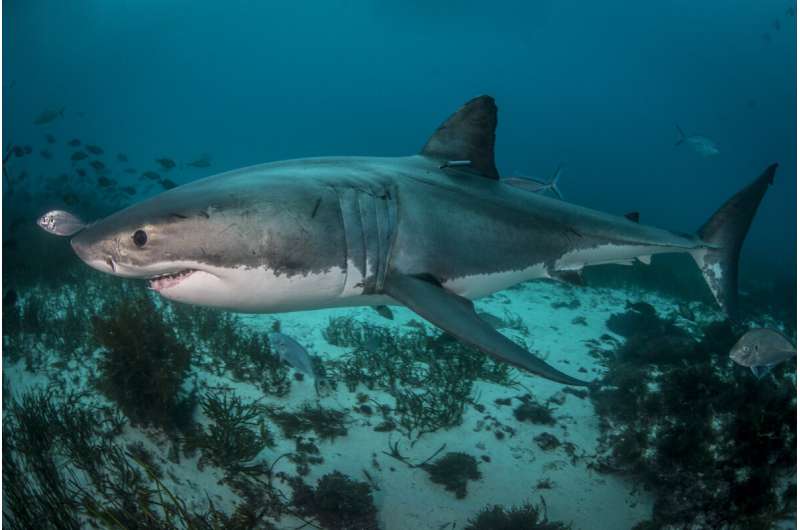White Shark. Credit: Andrew Fox, Rodney Fox Shark Expeditions
A team of 22 scientists have used data from the Integrated Marine Observing System (IMOS) to track the movements of marine organisms during the COVID-19 lockdown in a new study, revealing the impact of human activities on marine species in Australian waters.
With shark cage-diving as a case study, the research team, led by Associate Professor Charlie Huveneers from Flinders University, monitored the movements and residency of two marine species, white sharks and yellowtail kingfish, over a 51-day period during the longest break in cage-diving activity at the Neptune Islands near Port Lincoln for over 20 years.
"The various restrictions on human movements have led to an unprecedented global hiatus in anthropogenic activities, providing a unique opportunity to assess human impact on biological systems," says Associate Professor Huveneers.
Thanks to the ongoing monitoring program of the white shark cage-diving industry, the movements and residency of tagged white sharks and yellow kingfish were recorded using acoustic receivers deployed throughout the Neptune Islands.
"Our study showed that the movements of yellowtail kingfish were reduced when cage-diving boats were absent compared to periods of standard tourism operations. White sharks on the other hand did not seem affected by the break of tourism activities."
"While this might suggests that the 51-day break in tourism is not sufficient for white shark to return to their pre-tourism behavior, it can also be due to current regulations ensuring that the cage-diving industry has minimal impacts on white shark residency."
"This study shows how acoustic tracking can be used to analyze whether aquatic organisms have been affected by changes in anthropogenic activities during COVID-19, or more broadly how acoustic tracking can be used to quantify the effects of human disturbances on animal movement in the short term."
Credit: Flinders University
The IMOS Animal Tracking Facility network deploys and maintains a national array of acoustic receivers strategically located in waters around Australia to detect and track tagged animals.
Professor Rob Harcourt, Facility Leader IMOS Animal Tracking Facility, Sydney Institute of Marine Science says this study highlights the critical importance of maintaining time-series as only then can we reveal the effects of hitherto unforeseen events, such as COVID, on our fragile marine ecosystems.
CEO, Sydney Institute of Marine Science, Professor Martina Doblin says the study beautifully illustrates the utility of long-term time series of species movements collected Australia-wide by the IMOS Animal Tracking Facility, based at the Sydney Institute of Marine Science.
"As we enter the United Nations Decade of Ocean Science for Sustainable Development, such comprehensive datasets and monitoring programs are going to be pivotal to improving knowledge and management of marine ecosystems, both nationally and globally."
Associate Professor Huveneers says the data, published in the scientific journal Biological Conservation, will provide important insight into how acoustic tracking technology can be incorporated to analyze the impact of human behavior on marine ecosystems.
"Only with the existence of long-term, robust monitoring infrastructure like IMOS are we able to disentangle the complex interaction between long-term impacts such as climate change, coastal development, commercial fishing and short-term, acute impacts such as noise pollution, heat waves, seismic surveys, and oil spills which may drive step changes in systems."
"Our tracking roadmap is globally applicable and will assist researchers in designing studies to assess how anthropogenic activities can impact animal movement and distributions during regional, short-term through to major, unexpected disruptions like the COVID-19 pandemic."
More information: Charlie Huveneers et al. The power of national acoustic tracking networks to assess the impacts of human activity on marine organisms during the COVID-19 pandemic, Biological Conservation (2021). DOI: 10.1016/j.biocon.2021.108995
Journal information: Biological Conservation
Provided by Flinders University
























